Developmental Theories: A Case Study of “Into the Wild”
VerifiedAdded on 2022/10/15
|12
|3026
|331
AI Summary
This paper critically analyzes the developmental theories of Jean Piaget and Burrhus Frederic Skinner in the particular context of the movie “Into the Wild” and the decision of its protagonist, Christopher McCandless, to leave home.
Contribute Materials
Your contribution can guide someone’s learning journey. Share your
documents today.
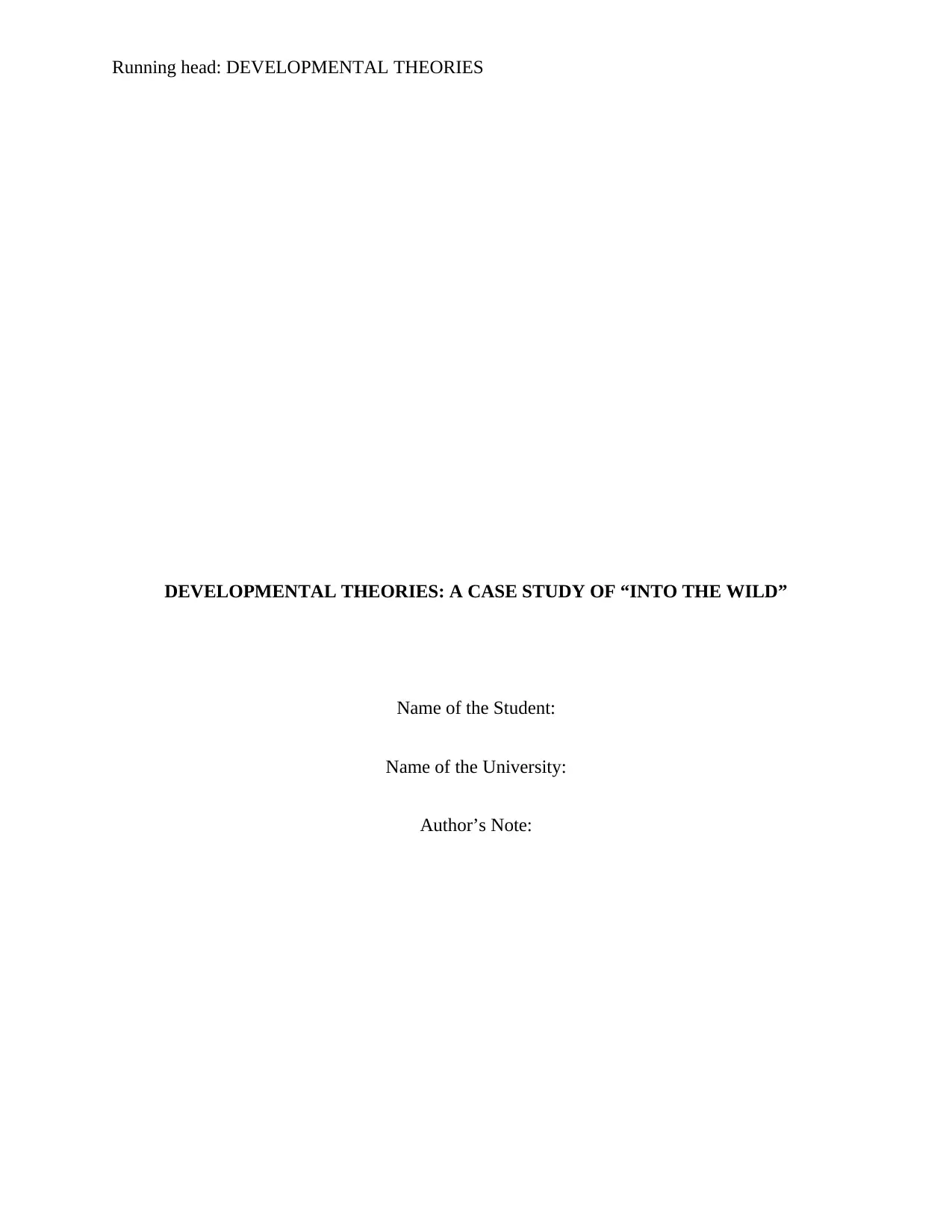
Running head: DEVELOPMENTAL THEORIES
DEVELOPMENTAL THEORIES: A CASE STUDY OF “INTO THE WILD”
Name of the Student:
Name of the University:
Author’s Note:
DEVELOPMENTAL THEORIES: A CASE STUDY OF “INTO THE WILD”
Name of the Student:
Name of the University:
Author’s Note:
Secure Best Marks with AI Grader
Need help grading? Try our AI Grader for instant feedback on your assignments.
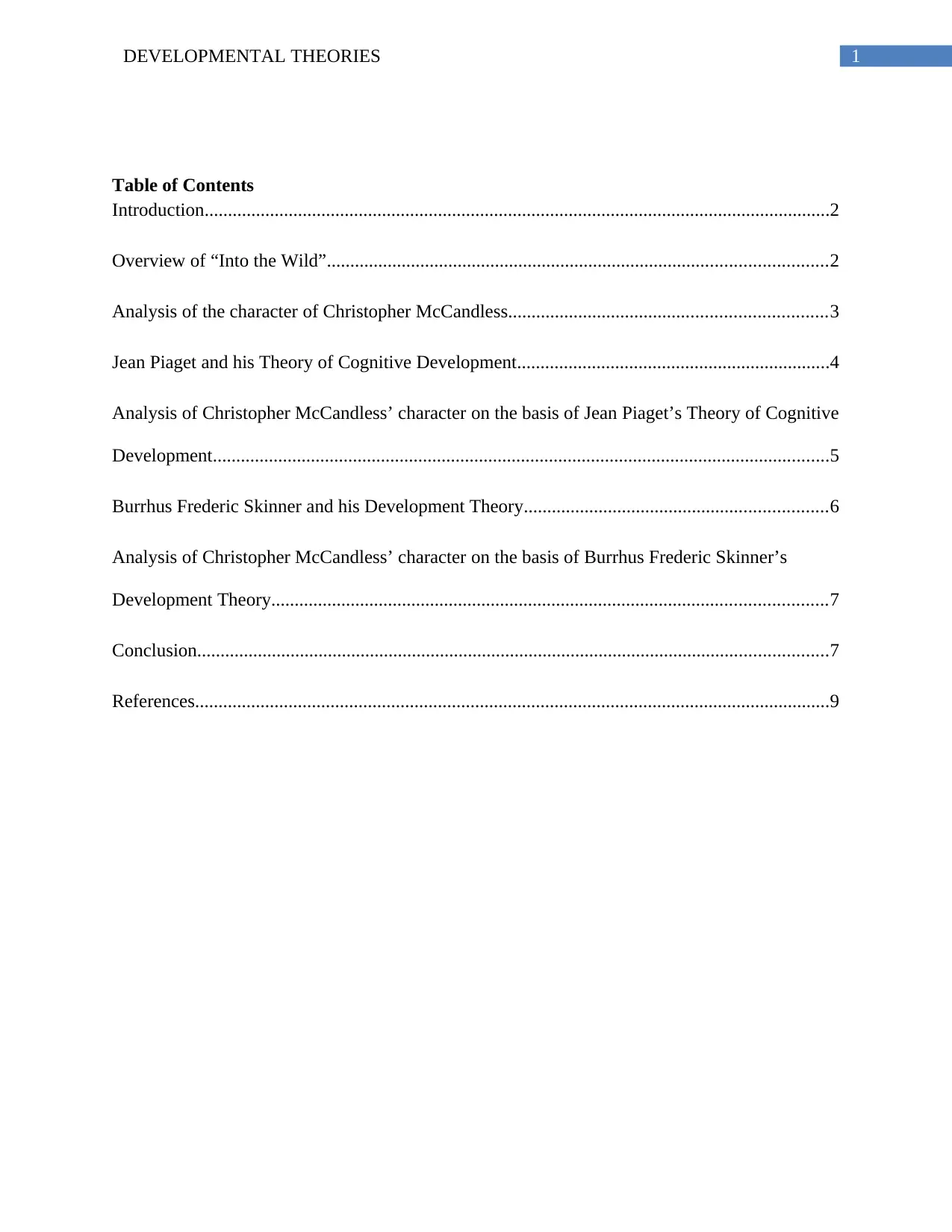
1DEVELOPMENTAL THEORIES
Table of Contents
Introduction......................................................................................................................................2
Overview of “Into the Wild”...........................................................................................................2
Analysis of the character of Christopher McCandless....................................................................3
Jean Piaget and his Theory of Cognitive Development...................................................................4
Analysis of Christopher McCandless’ character on the basis of Jean Piaget’s Theory of Cognitive
Development....................................................................................................................................5
Burrhus Frederic Skinner and his Development Theory.................................................................6
Analysis of Christopher McCandless’ character on the basis of Burrhus Frederic Skinner’s
Development Theory.......................................................................................................................7
Conclusion.......................................................................................................................................7
References........................................................................................................................................9
Table of Contents
Introduction......................................................................................................................................2
Overview of “Into the Wild”...........................................................................................................2
Analysis of the character of Christopher McCandless....................................................................3
Jean Piaget and his Theory of Cognitive Development...................................................................4
Analysis of Christopher McCandless’ character on the basis of Jean Piaget’s Theory of Cognitive
Development....................................................................................................................................5
Burrhus Frederic Skinner and his Development Theory.................................................................6
Analysis of Christopher McCandless’ character on the basis of Burrhus Frederic Skinner’s
Development Theory.......................................................................................................................7
Conclusion.......................................................................................................................................7
References........................................................................................................................................9
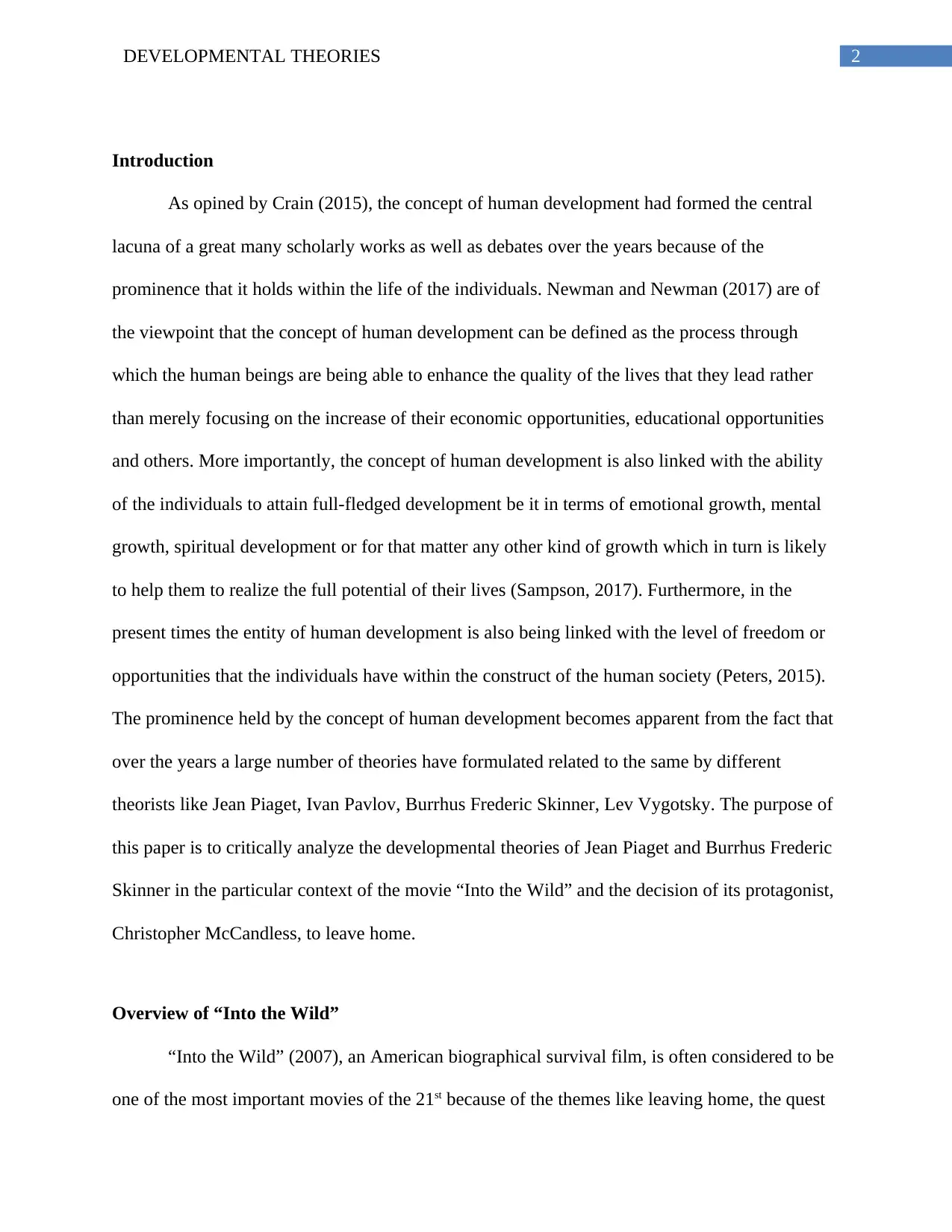
2DEVELOPMENTAL THEORIES
Introduction
As opined by Crain (2015), the concept of human development had formed the central
lacuna of a great many scholarly works as well as debates over the years because of the
prominence that it holds within the life of the individuals. Newman and Newman (2017) are of
the viewpoint that the concept of human development can be defined as the process through
which the human beings are being able to enhance the quality of the lives that they lead rather
than merely focusing on the increase of their economic opportunities, educational opportunities
and others. More importantly, the concept of human development is also linked with the ability
of the individuals to attain full-fledged development be it in terms of emotional growth, mental
growth, spiritual development or for that matter any other kind of growth which in turn is likely
to help them to realize the full potential of their lives (Sampson, 2017). Furthermore, in the
present times the entity of human development is also being linked with the level of freedom or
opportunities that the individuals have within the construct of the human society (Peters, 2015).
The prominence held by the concept of human development becomes apparent from the fact that
over the years a large number of theories have formulated related to the same by different
theorists like Jean Piaget, Ivan Pavlov, Burrhus Frederic Skinner, Lev Vygotsky. The purpose of
this paper is to critically analyze the developmental theories of Jean Piaget and Burrhus Frederic
Skinner in the particular context of the movie “Into the Wild” and the decision of its protagonist,
Christopher McCandless, to leave home.
Overview of “Into the Wild”
“Into the Wild” (2007), an American biographical survival film, is often considered to be
one of the most important movies of the 21st because of the themes like leaving home, the quest
Introduction
As opined by Crain (2015), the concept of human development had formed the central
lacuna of a great many scholarly works as well as debates over the years because of the
prominence that it holds within the life of the individuals. Newman and Newman (2017) are of
the viewpoint that the concept of human development can be defined as the process through
which the human beings are being able to enhance the quality of the lives that they lead rather
than merely focusing on the increase of their economic opportunities, educational opportunities
and others. More importantly, the concept of human development is also linked with the ability
of the individuals to attain full-fledged development be it in terms of emotional growth, mental
growth, spiritual development or for that matter any other kind of growth which in turn is likely
to help them to realize the full potential of their lives (Sampson, 2017). Furthermore, in the
present times the entity of human development is also being linked with the level of freedom or
opportunities that the individuals have within the construct of the human society (Peters, 2015).
The prominence held by the concept of human development becomes apparent from the fact that
over the years a large number of theories have formulated related to the same by different
theorists like Jean Piaget, Ivan Pavlov, Burrhus Frederic Skinner, Lev Vygotsky. The purpose of
this paper is to critically analyze the developmental theories of Jean Piaget and Burrhus Frederic
Skinner in the particular context of the movie “Into the Wild” and the decision of its protagonist,
Christopher McCandless, to leave home.
Overview of “Into the Wild”
“Into the Wild” (2007), an American biographical survival film, is often considered to be
one of the most important movies of the 21st because of the themes like leaving home, the quest
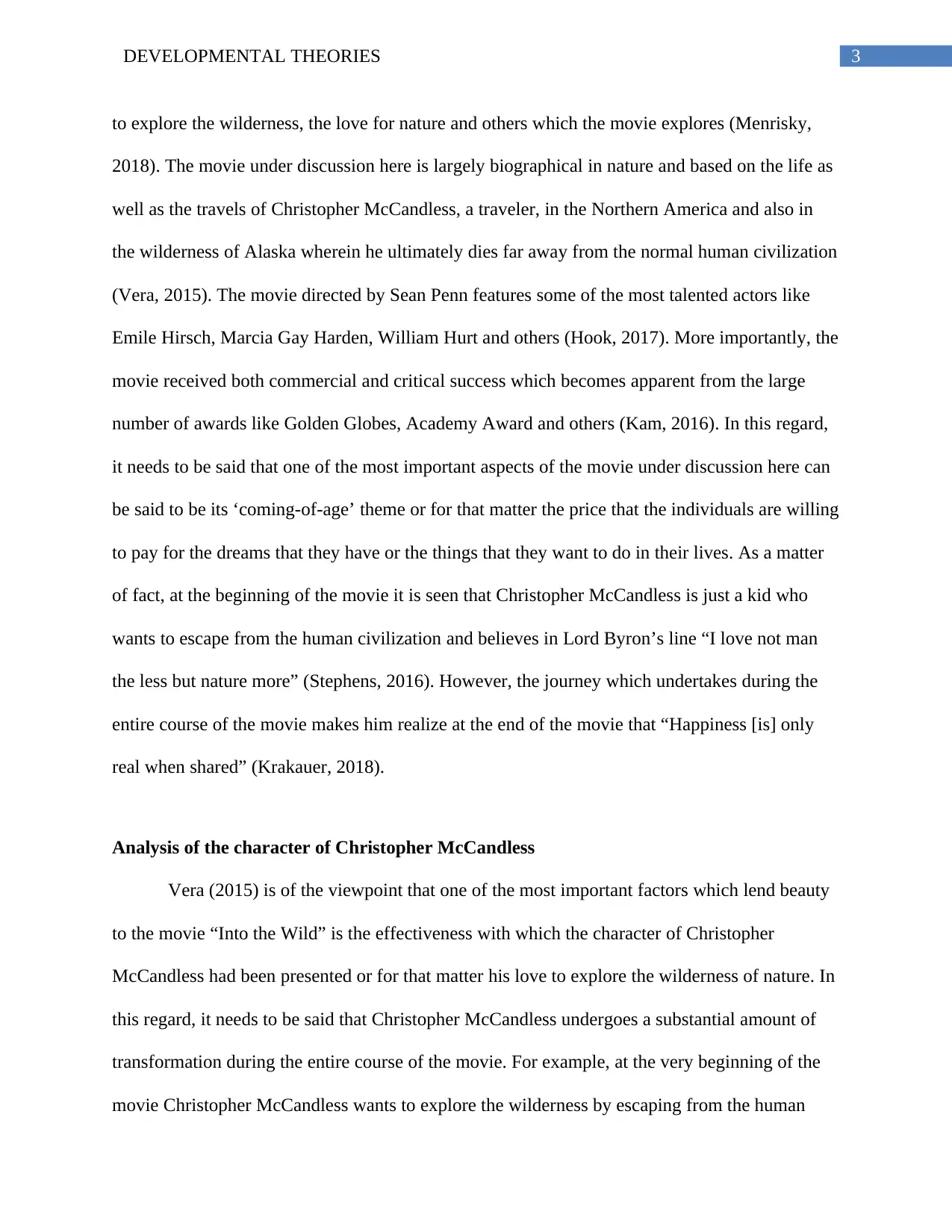
3DEVELOPMENTAL THEORIES
to explore the wilderness, the love for nature and others which the movie explores (Menrisky,
2018). The movie under discussion here is largely biographical in nature and based on the life as
well as the travels of Christopher McCandless, a traveler, in the Northern America and also in
the wilderness of Alaska wherein he ultimately dies far away from the normal human civilization
(Vera, 2015). The movie directed by Sean Penn features some of the most talented actors like
Emile Hirsch, Marcia Gay Harden, William Hurt and others (Hook, 2017). More importantly, the
movie received both commercial and critical success which becomes apparent from the large
number of awards like Golden Globes, Academy Award and others (Kam, 2016). In this regard,
it needs to be said that one of the most important aspects of the movie under discussion here can
be said to be its ‘coming-of-age’ theme or for that matter the price that the individuals are willing
to pay for the dreams that they have or the things that they want to do in their lives. As a matter
of fact, at the beginning of the movie it is seen that Christopher McCandless is just a kid who
wants to escape from the human civilization and believes in Lord Byron’s line “I love not man
the less but nature more” (Stephens, 2016). However, the journey which undertakes during the
entire course of the movie makes him realize at the end of the movie that “Happiness [is] only
real when shared” (Krakauer, 2018).
Analysis of the character of Christopher McCandless
Vera (2015) is of the viewpoint that one of the most important factors which lend beauty
to the movie “Into the Wild” is the effectiveness with which the character of Christopher
McCandless had been presented or for that matter his love to explore the wilderness of nature. In
this regard, it needs to be said that Christopher McCandless undergoes a substantial amount of
transformation during the entire course of the movie. For example, at the very beginning of the
movie Christopher McCandless wants to explore the wilderness by escaping from the human
to explore the wilderness, the love for nature and others which the movie explores (Menrisky,
2018). The movie under discussion here is largely biographical in nature and based on the life as
well as the travels of Christopher McCandless, a traveler, in the Northern America and also in
the wilderness of Alaska wherein he ultimately dies far away from the normal human civilization
(Vera, 2015). The movie directed by Sean Penn features some of the most talented actors like
Emile Hirsch, Marcia Gay Harden, William Hurt and others (Hook, 2017). More importantly, the
movie received both commercial and critical success which becomes apparent from the large
number of awards like Golden Globes, Academy Award and others (Kam, 2016). In this regard,
it needs to be said that one of the most important aspects of the movie under discussion here can
be said to be its ‘coming-of-age’ theme or for that matter the price that the individuals are willing
to pay for the dreams that they have or the things that they want to do in their lives. As a matter
of fact, at the beginning of the movie it is seen that Christopher McCandless is just a kid who
wants to escape from the human civilization and believes in Lord Byron’s line “I love not man
the less but nature more” (Stephens, 2016). However, the journey which undertakes during the
entire course of the movie makes him realize at the end of the movie that “Happiness [is] only
real when shared” (Krakauer, 2018).
Analysis of the character of Christopher McCandless
Vera (2015) is of the viewpoint that one of the most important factors which lend beauty
to the movie “Into the Wild” is the effectiveness with which the character of Christopher
McCandless had been presented or for that matter his love to explore the wilderness of nature. In
this regard, it needs to be said that Christopher McCandless undergoes a substantial amount of
transformation during the entire course of the movie. For example, at the very beginning of the
movie Christopher McCandless wants to explore the wilderness by escaping from the human
Paraphrase This Document
Need a fresh take? Get an instant paraphrase of this document with our AI Paraphraser
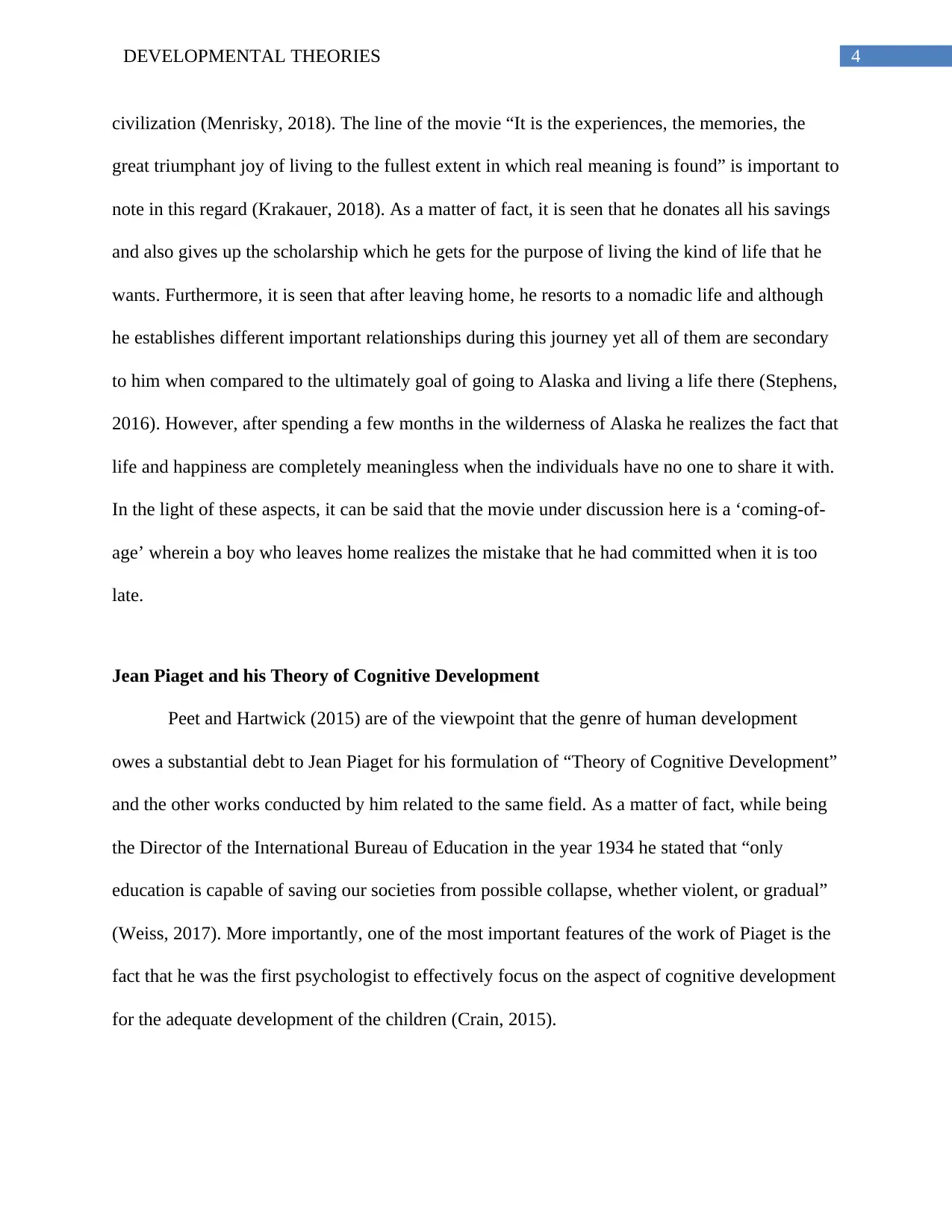
4DEVELOPMENTAL THEORIES
civilization (Menrisky, 2018). The line of the movie “It is the experiences, the memories, the
great triumphant joy of living to the fullest extent in which real meaning is found” is important to
note in this regard (Krakauer, 2018). As a matter of fact, it is seen that he donates all his savings
and also gives up the scholarship which he gets for the purpose of living the kind of life that he
wants. Furthermore, it is seen that after leaving home, he resorts to a nomadic life and although
he establishes different important relationships during this journey yet all of them are secondary
to him when compared to the ultimately goal of going to Alaska and living a life there (Stephens,
2016). However, after spending a few months in the wilderness of Alaska he realizes the fact that
life and happiness are completely meaningless when the individuals have no one to share it with.
In the light of these aspects, it can be said that the movie under discussion here is a ‘coming-of-
age’ wherein a boy who leaves home realizes the mistake that he had committed when it is too
late.
Jean Piaget and his Theory of Cognitive Development
Peet and Hartwick (2015) are of the viewpoint that the genre of human development
owes a substantial debt to Jean Piaget for his formulation of “Theory of Cognitive Development”
and the other works conducted by him related to the same field. As a matter of fact, while being
the Director of the International Bureau of Education in the year 1934 he stated that “only
education is capable of saving our societies from possible collapse, whether violent, or gradual”
(Weiss, 2017). More importantly, one of the most important features of the work of Piaget is the
fact that he was the first psychologist to effectively focus on the aspect of cognitive development
for the adequate development of the children (Crain, 2015).
civilization (Menrisky, 2018). The line of the movie “It is the experiences, the memories, the
great triumphant joy of living to the fullest extent in which real meaning is found” is important to
note in this regard (Krakauer, 2018). As a matter of fact, it is seen that he donates all his savings
and also gives up the scholarship which he gets for the purpose of living the kind of life that he
wants. Furthermore, it is seen that after leaving home, he resorts to a nomadic life and although
he establishes different important relationships during this journey yet all of them are secondary
to him when compared to the ultimately goal of going to Alaska and living a life there (Stephens,
2016). However, after spending a few months in the wilderness of Alaska he realizes the fact that
life and happiness are completely meaningless when the individuals have no one to share it with.
In the light of these aspects, it can be said that the movie under discussion here is a ‘coming-of-
age’ wherein a boy who leaves home realizes the mistake that he had committed when it is too
late.
Jean Piaget and his Theory of Cognitive Development
Peet and Hartwick (2015) are of the viewpoint that the genre of human development
owes a substantial debt to Jean Piaget for his formulation of “Theory of Cognitive Development”
and the other works conducted by him related to the same field. As a matter of fact, while being
the Director of the International Bureau of Education in the year 1934 he stated that “only
education is capable of saving our societies from possible collapse, whether violent, or gradual”
(Weiss, 2017). More importantly, one of the most important features of the work of Piaget is the
fact that he was the first psychologist to effectively focus on the aspect of cognitive development
for the adequate development of the children (Crain, 2015).
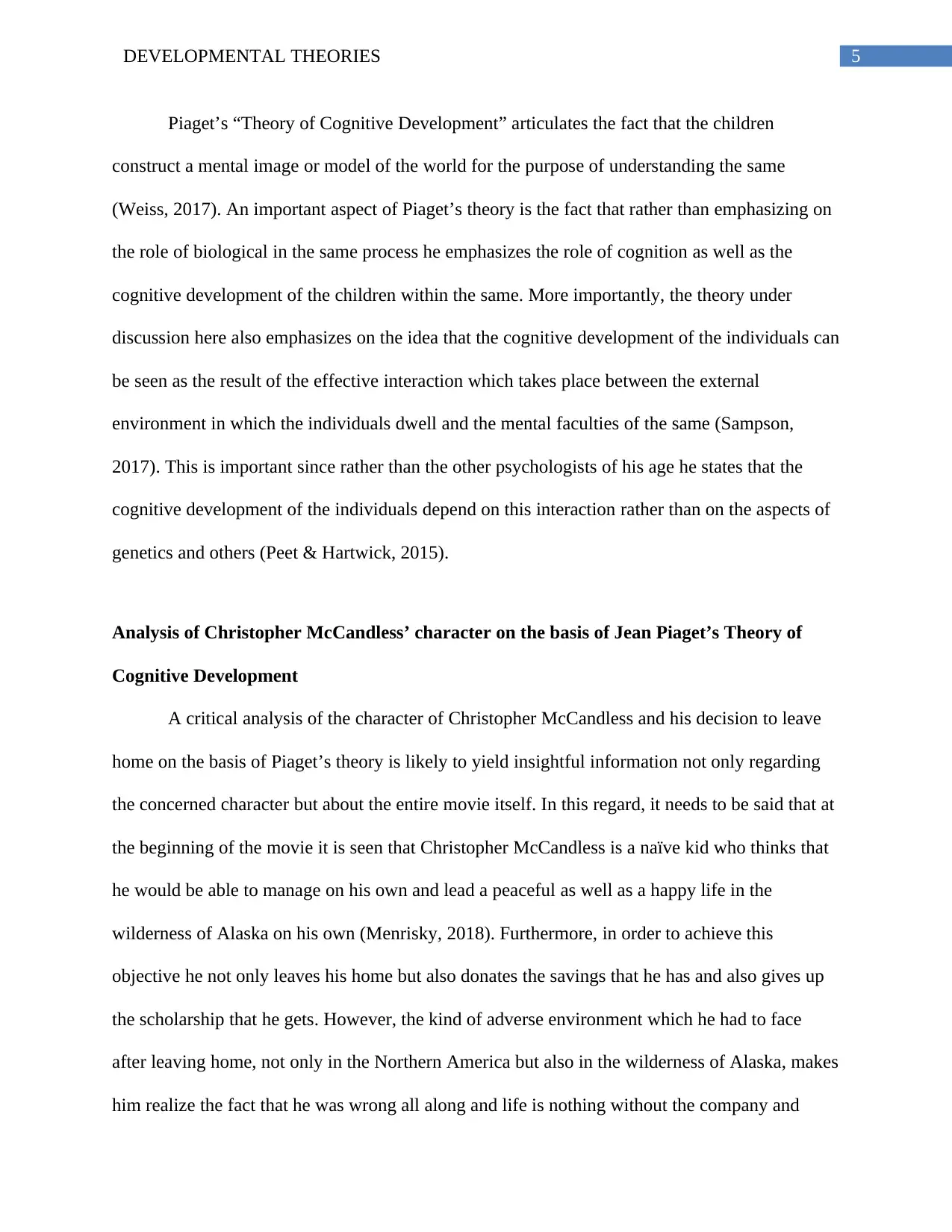
5DEVELOPMENTAL THEORIES
Piaget’s “Theory of Cognitive Development” articulates the fact that the children
construct a mental image or model of the world for the purpose of understanding the same
(Weiss, 2017). An important aspect of Piaget’s theory is the fact that rather than emphasizing on
the role of biological in the same process he emphasizes the role of cognition as well as the
cognitive development of the children within the same. More importantly, the theory under
discussion here also emphasizes on the idea that the cognitive development of the individuals can
be seen as the result of the effective interaction which takes place between the external
environment in which the individuals dwell and the mental faculties of the same (Sampson,
2017). This is important since rather than the other psychologists of his age he states that the
cognitive development of the individuals depend on this interaction rather than on the aspects of
genetics and others (Peet & Hartwick, 2015).
Analysis of Christopher McCandless’ character on the basis of Jean Piaget’s Theory of
Cognitive Development
A critical analysis of the character of Christopher McCandless and his decision to leave
home on the basis of Piaget’s theory is likely to yield insightful information not only regarding
the concerned character but about the entire movie itself. In this regard, it needs to be said that at
the beginning of the movie it is seen that Christopher McCandless is a naïve kid who thinks that
he would be able to manage on his own and lead a peaceful as well as a happy life in the
wilderness of Alaska on his own (Menrisky, 2018). Furthermore, in order to achieve this
objective he not only leaves his home but also donates the savings that he has and also gives up
the scholarship that he gets. However, the kind of adverse environment which he had to face
after leaving home, not only in the Northern America but also in the wilderness of Alaska, makes
him realize the fact that he was wrong all along and life is nothing without the company and
Piaget’s “Theory of Cognitive Development” articulates the fact that the children
construct a mental image or model of the world for the purpose of understanding the same
(Weiss, 2017). An important aspect of Piaget’s theory is the fact that rather than emphasizing on
the role of biological in the same process he emphasizes the role of cognition as well as the
cognitive development of the children within the same. More importantly, the theory under
discussion here also emphasizes on the idea that the cognitive development of the individuals can
be seen as the result of the effective interaction which takes place between the external
environment in which the individuals dwell and the mental faculties of the same (Sampson,
2017). This is important since rather than the other psychologists of his age he states that the
cognitive development of the individuals depend on this interaction rather than on the aspects of
genetics and others (Peet & Hartwick, 2015).
Analysis of Christopher McCandless’ character on the basis of Jean Piaget’s Theory of
Cognitive Development
A critical analysis of the character of Christopher McCandless and his decision to leave
home on the basis of Piaget’s theory is likely to yield insightful information not only regarding
the concerned character but about the entire movie itself. In this regard, it needs to be said that at
the beginning of the movie it is seen that Christopher McCandless is a naïve kid who thinks that
he would be able to manage on his own and lead a peaceful as well as a happy life in the
wilderness of Alaska on his own (Menrisky, 2018). Furthermore, in order to achieve this
objective he not only leaves his home but also donates the savings that he has and also gives up
the scholarship that he gets. However, the kind of adverse environment which he had to face
after leaving home, not only in the Northern America but also in the wilderness of Alaska, makes
him realize the fact that he was wrong all along and life is nothing without the company and
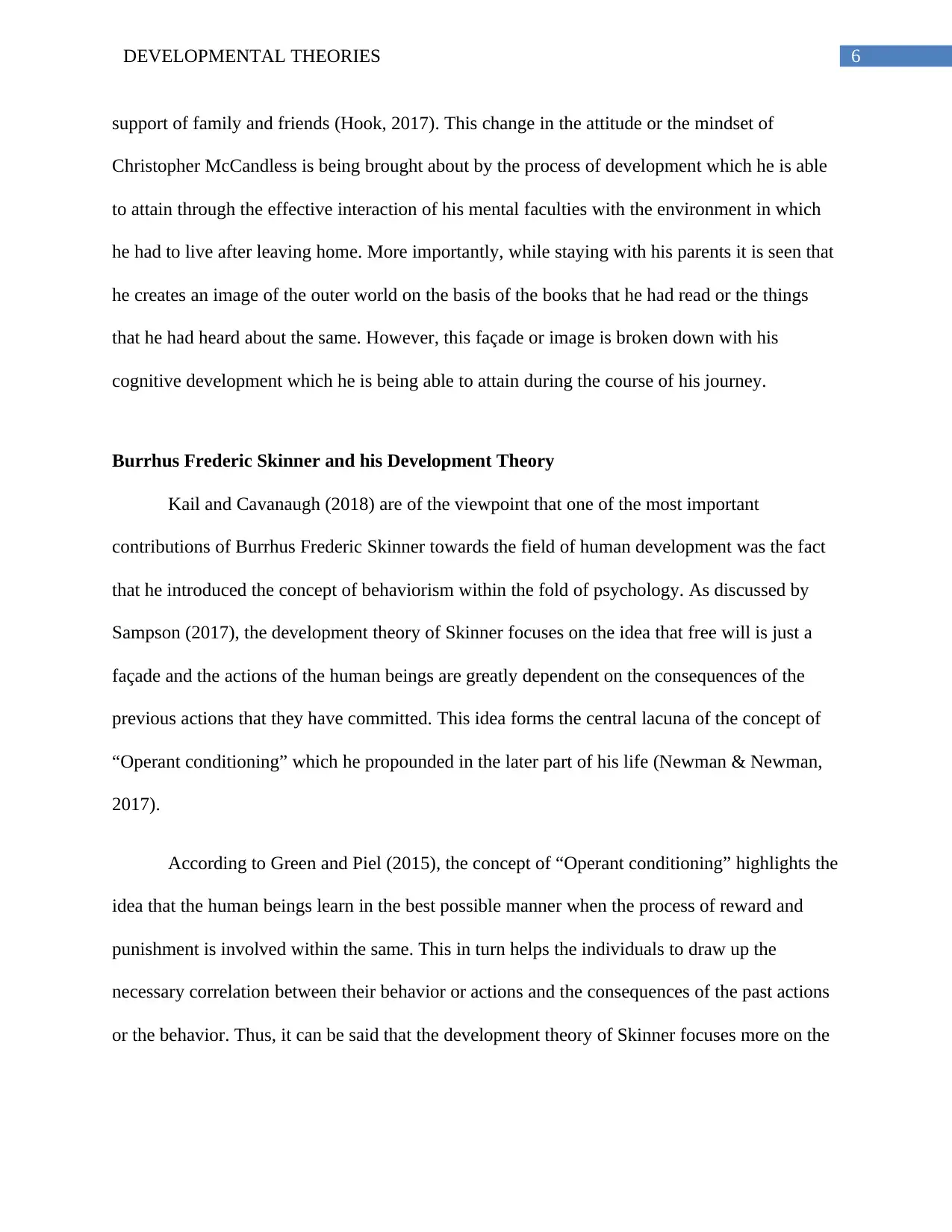
6DEVELOPMENTAL THEORIES
support of family and friends (Hook, 2017). This change in the attitude or the mindset of
Christopher McCandless is being brought about by the process of development which he is able
to attain through the effective interaction of his mental faculties with the environment in which
he had to live after leaving home. More importantly, while staying with his parents it is seen that
he creates an image of the outer world on the basis of the books that he had read or the things
that he had heard about the same. However, this façade or image is broken down with his
cognitive development which he is being able to attain during the course of his journey.
Burrhus Frederic Skinner and his Development Theory
Kail and Cavanaugh (2018) are of the viewpoint that one of the most important
contributions of Burrhus Frederic Skinner towards the field of human development was the fact
that he introduced the concept of behaviorism within the fold of psychology. As discussed by
Sampson (2017), the development theory of Skinner focuses on the idea that free will is just a
façade and the actions of the human beings are greatly dependent on the consequences of the
previous actions that they have committed. This idea forms the central lacuna of the concept of
“Operant conditioning” which he propounded in the later part of his life (Newman & Newman,
2017).
According to Green and Piel (2015), the concept of “Operant conditioning” highlights the
idea that the human beings learn in the best possible manner when the process of reward and
punishment is involved within the same. This in turn helps the individuals to draw up the
necessary correlation between their behavior or actions and the consequences of the past actions
or the behavior. Thus, it can be said that the development theory of Skinner focuses more on the
support of family and friends (Hook, 2017). This change in the attitude or the mindset of
Christopher McCandless is being brought about by the process of development which he is able
to attain through the effective interaction of his mental faculties with the environment in which
he had to live after leaving home. More importantly, while staying with his parents it is seen that
he creates an image of the outer world on the basis of the books that he had read or the things
that he had heard about the same. However, this façade or image is broken down with his
cognitive development which he is being able to attain during the course of his journey.
Burrhus Frederic Skinner and his Development Theory
Kail and Cavanaugh (2018) are of the viewpoint that one of the most important
contributions of Burrhus Frederic Skinner towards the field of human development was the fact
that he introduced the concept of behaviorism within the fold of psychology. As discussed by
Sampson (2017), the development theory of Skinner focuses on the idea that free will is just a
façade and the actions of the human beings are greatly dependent on the consequences of the
previous actions that they have committed. This idea forms the central lacuna of the concept of
“Operant conditioning” which he propounded in the later part of his life (Newman & Newman,
2017).
According to Green and Piel (2015), the concept of “Operant conditioning” highlights the
idea that the human beings learn in the best possible manner when the process of reward and
punishment is involved within the same. This in turn helps the individuals to draw up the
necessary correlation between their behavior or actions and the consequences of the past actions
or the behavior. Thus, it can be said that the development theory of Skinner focuses more on the
Secure Best Marks with AI Grader
Need help grading? Try our AI Grader for instant feedback on your assignments.
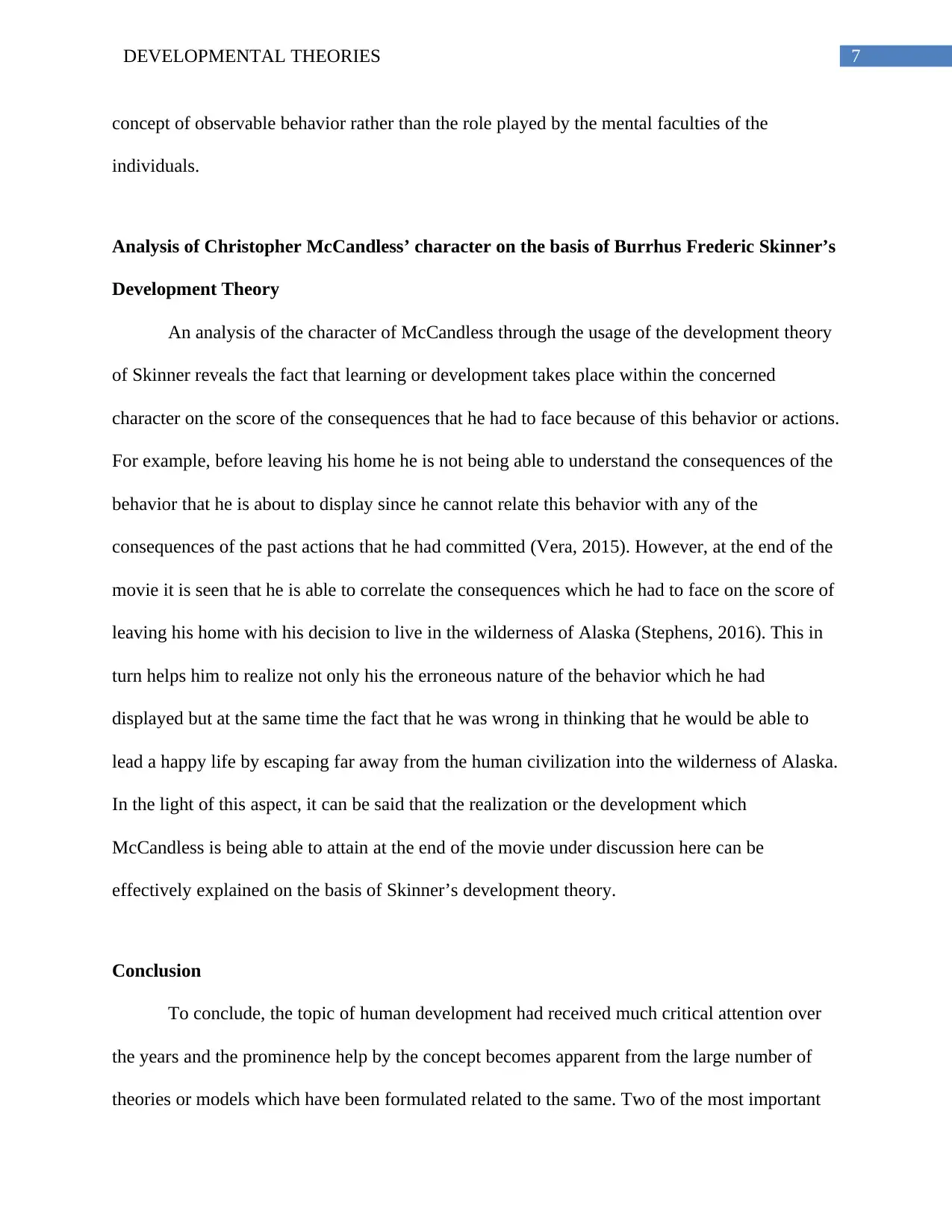
7DEVELOPMENTAL THEORIES
concept of observable behavior rather than the role played by the mental faculties of the
individuals.
Analysis of Christopher McCandless’ character on the basis of Burrhus Frederic Skinner’s
Development Theory
An analysis of the character of McCandless through the usage of the development theory
of Skinner reveals the fact that learning or development takes place within the concerned
character on the score of the consequences that he had to face because of this behavior or actions.
For example, before leaving his home he is not being able to understand the consequences of the
behavior that he is about to display since he cannot relate this behavior with any of the
consequences of the past actions that he had committed (Vera, 2015). However, at the end of the
movie it is seen that he is able to correlate the consequences which he had to face on the score of
leaving his home with his decision to live in the wilderness of Alaska (Stephens, 2016). This in
turn helps him to realize not only his the erroneous nature of the behavior which he had
displayed but at the same time the fact that he was wrong in thinking that he would be able to
lead a happy life by escaping far away from the human civilization into the wilderness of Alaska.
In the light of this aspect, it can be said that the realization or the development which
McCandless is being able to attain at the end of the movie under discussion here can be
effectively explained on the basis of Skinner’s development theory.
Conclusion
To conclude, the topic of human development had received much critical attention over
the years and the prominence help by the concept becomes apparent from the large number of
theories or models which have been formulated related to the same. Two of the most important
concept of observable behavior rather than the role played by the mental faculties of the
individuals.
Analysis of Christopher McCandless’ character on the basis of Burrhus Frederic Skinner’s
Development Theory
An analysis of the character of McCandless through the usage of the development theory
of Skinner reveals the fact that learning or development takes place within the concerned
character on the score of the consequences that he had to face because of this behavior or actions.
For example, before leaving his home he is not being able to understand the consequences of the
behavior that he is about to display since he cannot relate this behavior with any of the
consequences of the past actions that he had committed (Vera, 2015). However, at the end of the
movie it is seen that he is able to correlate the consequences which he had to face on the score of
leaving his home with his decision to live in the wilderness of Alaska (Stephens, 2016). This in
turn helps him to realize not only his the erroneous nature of the behavior which he had
displayed but at the same time the fact that he was wrong in thinking that he would be able to
lead a happy life by escaping far away from the human civilization into the wilderness of Alaska.
In the light of this aspect, it can be said that the realization or the development which
McCandless is being able to attain at the end of the movie under discussion here can be
effectively explained on the basis of Skinner’s development theory.
Conclusion
To conclude, the topic of human development had received much critical attention over
the years and the prominence help by the concept becomes apparent from the large number of
theories or models which have been formulated related to the same. Two of the most important
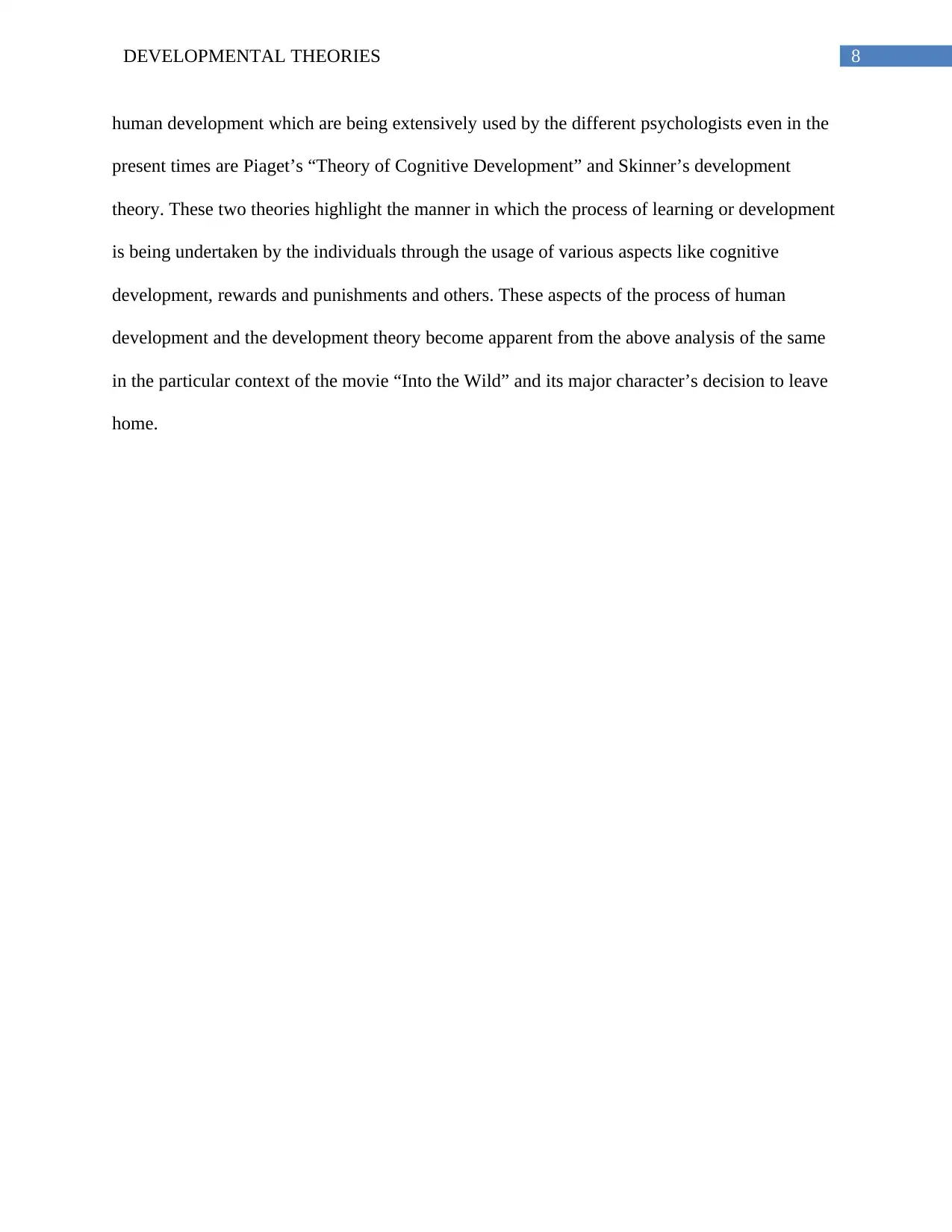
8DEVELOPMENTAL THEORIES
human development which are being extensively used by the different psychologists even in the
present times are Piaget’s “Theory of Cognitive Development” and Skinner’s development
theory. These two theories highlight the manner in which the process of learning or development
is being undertaken by the individuals through the usage of various aspects like cognitive
development, rewards and punishments and others. These aspects of the process of human
development and the development theory become apparent from the above analysis of the same
in the particular context of the movie “Into the Wild” and its major character’s decision to leave
home.
human development which are being extensively used by the different psychologists even in the
present times are Piaget’s “Theory of Cognitive Development” and Skinner’s development
theory. These two theories highlight the manner in which the process of learning or development
is being undertaken by the individuals through the usage of various aspects like cognitive
development, rewards and punishments and others. These aspects of the process of human
development and the development theory become apparent from the above analysis of the same
in the particular context of the movie “Into the Wild” and its major character’s decision to leave
home.
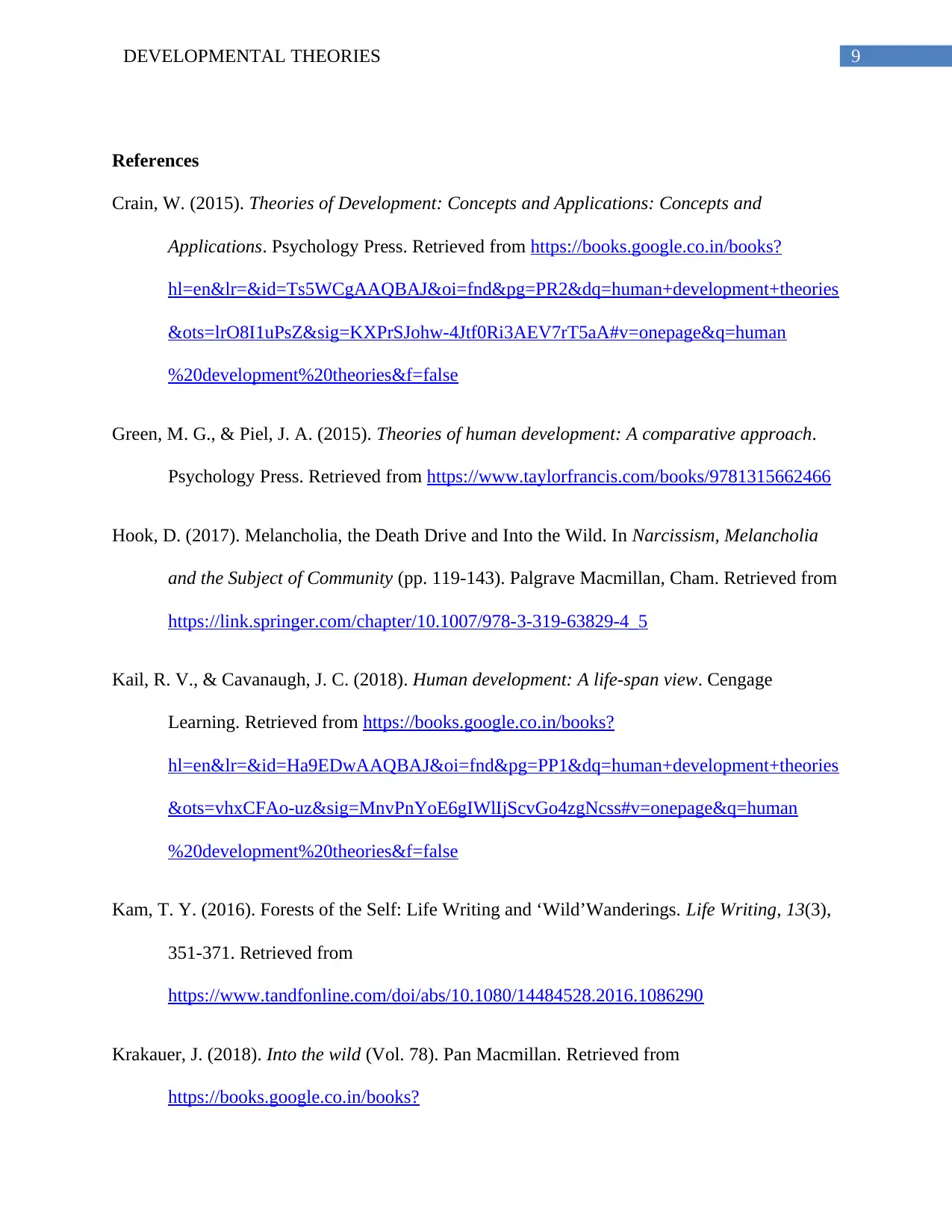
9DEVELOPMENTAL THEORIES
References
Crain, W. (2015). Theories of Development: Concepts and Applications: Concepts and
Applications. Psychology Press. Retrieved from https://books.google.co.in/books?
hl=en&lr=&id=Ts5WCgAAQBAJ&oi=fnd&pg=PR2&dq=human+development+theories
&ots=lrO8I1uPsZ&sig=KXPrSJohw-4Jtf0Ri3AEV7rT5aA#v=onepage&q=human
%20development%20theories&f=false
Green, M. G., & Piel, J. A. (2015). Theories of human development: A comparative approach.
Psychology Press. Retrieved from https://www.taylorfrancis.com/books/9781315662466
Hook, D. (2017). Melancholia, the Death Drive and Into the Wild. In Narcissism, Melancholia
and the Subject of Community (pp. 119-143). Palgrave Macmillan, Cham. Retrieved from
https://link.springer.com/chapter/10.1007/978-3-319-63829-4_5
Kail, R. V., & Cavanaugh, J. C. (2018). Human development: A life-span view. Cengage
Learning. Retrieved from https://books.google.co.in/books?
hl=en&lr=&id=Ha9EDwAAQBAJ&oi=fnd&pg=PP1&dq=human+development+theories
&ots=vhxCFAo-uz&sig=MnvPnYoE6gIWlIjScvGo4zgNcss#v=onepage&q=human
%20development%20theories&f=false
Kam, T. Y. (2016). Forests of the Self: Life Writing and ‘Wild’Wanderings. Life Writing, 13(3),
351-371. Retrieved from
https://www.tandfonline.com/doi/abs/10.1080/14484528.2016.1086290
Krakauer, J. (2018). Into the wild (Vol. 78). Pan Macmillan. Retrieved from
https://books.google.co.in/books?
References
Crain, W. (2015). Theories of Development: Concepts and Applications: Concepts and
Applications. Psychology Press. Retrieved from https://books.google.co.in/books?
hl=en&lr=&id=Ts5WCgAAQBAJ&oi=fnd&pg=PR2&dq=human+development+theories
&ots=lrO8I1uPsZ&sig=KXPrSJohw-4Jtf0Ri3AEV7rT5aA#v=onepage&q=human
%20development%20theories&f=false
Green, M. G., & Piel, J. A. (2015). Theories of human development: A comparative approach.
Psychology Press. Retrieved from https://www.taylorfrancis.com/books/9781315662466
Hook, D. (2017). Melancholia, the Death Drive and Into the Wild. In Narcissism, Melancholia
and the Subject of Community (pp. 119-143). Palgrave Macmillan, Cham. Retrieved from
https://link.springer.com/chapter/10.1007/978-3-319-63829-4_5
Kail, R. V., & Cavanaugh, J. C. (2018). Human development: A life-span view. Cengage
Learning. Retrieved from https://books.google.co.in/books?
hl=en&lr=&id=Ha9EDwAAQBAJ&oi=fnd&pg=PP1&dq=human+development+theories
&ots=vhxCFAo-uz&sig=MnvPnYoE6gIWlIjScvGo4zgNcss#v=onepage&q=human
%20development%20theories&f=false
Kam, T. Y. (2016). Forests of the Self: Life Writing and ‘Wild’Wanderings. Life Writing, 13(3),
351-371. Retrieved from
https://www.tandfonline.com/doi/abs/10.1080/14484528.2016.1086290
Krakauer, J. (2018). Into the wild (Vol. 78). Pan Macmillan. Retrieved from
https://books.google.co.in/books?
Paraphrase This Document
Need a fresh take? Get an instant paraphrase of this document with our AI Paraphraser

10DEVELOPMENTAL THEORIES
hl=en&lr=&id=m9BiDwAAQBAJ&oi=fnd&pg=PT19&dq=into+the+wild+chris+mccan
dless&ots=3gYY_2HkHb&sig=iKY5Tcd_8RZej2xAfKavWmckMuA#v=onepage&q=int
o%20the%20wild%20chris%20mccandless&f=false
Menrisky, A. (2018). The Natural Death of Alexander Supertramp: Ecological Selfhood and the
Freudian Rhetoric of Into the Wild. ISLE: Interdisciplinary Studies in Literature and
Environment, 26(1), 46-64. Retrieved from https://academic.oup.com/isle/article-
abstract/26/1/46/5255648
Newman, B. M., & Newman, P. R. (2017). Development through life: A psychosocial approach.
Cengage Learning. Retrieved from https://books.google.co.in/books?
hl=en&lr=&id=lD2dDgAAQBAJ&oi=fnd&pg=PP1&dq=human+development+theories
&ots=_7ViVnYbND&sig=NsAXQSqMApl3ATddF--klHfZ6RY#v=onepage&q=human
%20development%20theories&f=false
Peet, R., & Hartwick, E. (2015). Theories of development: Contentions, arguments, alternatives.
Guilford Publications. Retrieved from https://books.google.co.in/books?
hl=en&lr=&id=sI39CAAAQBAJ&oi=fnd&pg=PP1&dq=human+development+theories
&ots=P4HWl-lvCz&sig=o-feoKm6bJCEhwxkrselBaNqKFQ#v=onepage&q=human
%20development%20theories&f=false
Peters, R. S. (2015). Psychology and Ethical Development (Routledge Revivals): A Collection of
Articles on Psychological Theories, Ethical Development and Human Understanding.
Routledge. Retrieved from https://www.taylorfrancis.com/books/9781315712345
Sampson, R. J. (2017). Family management and child development: Insights from social
disorganization theory. In Facts, frameworks, and forecasts (pp. 63-94). Routledge.
hl=en&lr=&id=m9BiDwAAQBAJ&oi=fnd&pg=PT19&dq=into+the+wild+chris+mccan
dless&ots=3gYY_2HkHb&sig=iKY5Tcd_8RZej2xAfKavWmckMuA#v=onepage&q=int
o%20the%20wild%20chris%20mccandless&f=false
Menrisky, A. (2018). The Natural Death of Alexander Supertramp: Ecological Selfhood and the
Freudian Rhetoric of Into the Wild. ISLE: Interdisciplinary Studies in Literature and
Environment, 26(1), 46-64. Retrieved from https://academic.oup.com/isle/article-
abstract/26/1/46/5255648
Newman, B. M., & Newman, P. R. (2017). Development through life: A psychosocial approach.
Cengage Learning. Retrieved from https://books.google.co.in/books?
hl=en&lr=&id=lD2dDgAAQBAJ&oi=fnd&pg=PP1&dq=human+development+theories
&ots=_7ViVnYbND&sig=NsAXQSqMApl3ATddF--klHfZ6RY#v=onepage&q=human
%20development%20theories&f=false
Peet, R., & Hartwick, E. (2015). Theories of development: Contentions, arguments, alternatives.
Guilford Publications. Retrieved from https://books.google.co.in/books?
hl=en&lr=&id=sI39CAAAQBAJ&oi=fnd&pg=PP1&dq=human+development+theories
&ots=P4HWl-lvCz&sig=o-feoKm6bJCEhwxkrselBaNqKFQ#v=onepage&q=human
%20development%20theories&f=false
Peters, R. S. (2015). Psychology and Ethical Development (Routledge Revivals): A Collection of
Articles on Psychological Theories, Ethical Development and Human Understanding.
Routledge. Retrieved from https://www.taylorfrancis.com/books/9781315712345
Sampson, R. J. (2017). Family management and child development: Insights from social
disorganization theory. In Facts, frameworks, and forecasts (pp. 63-94). Routledge.
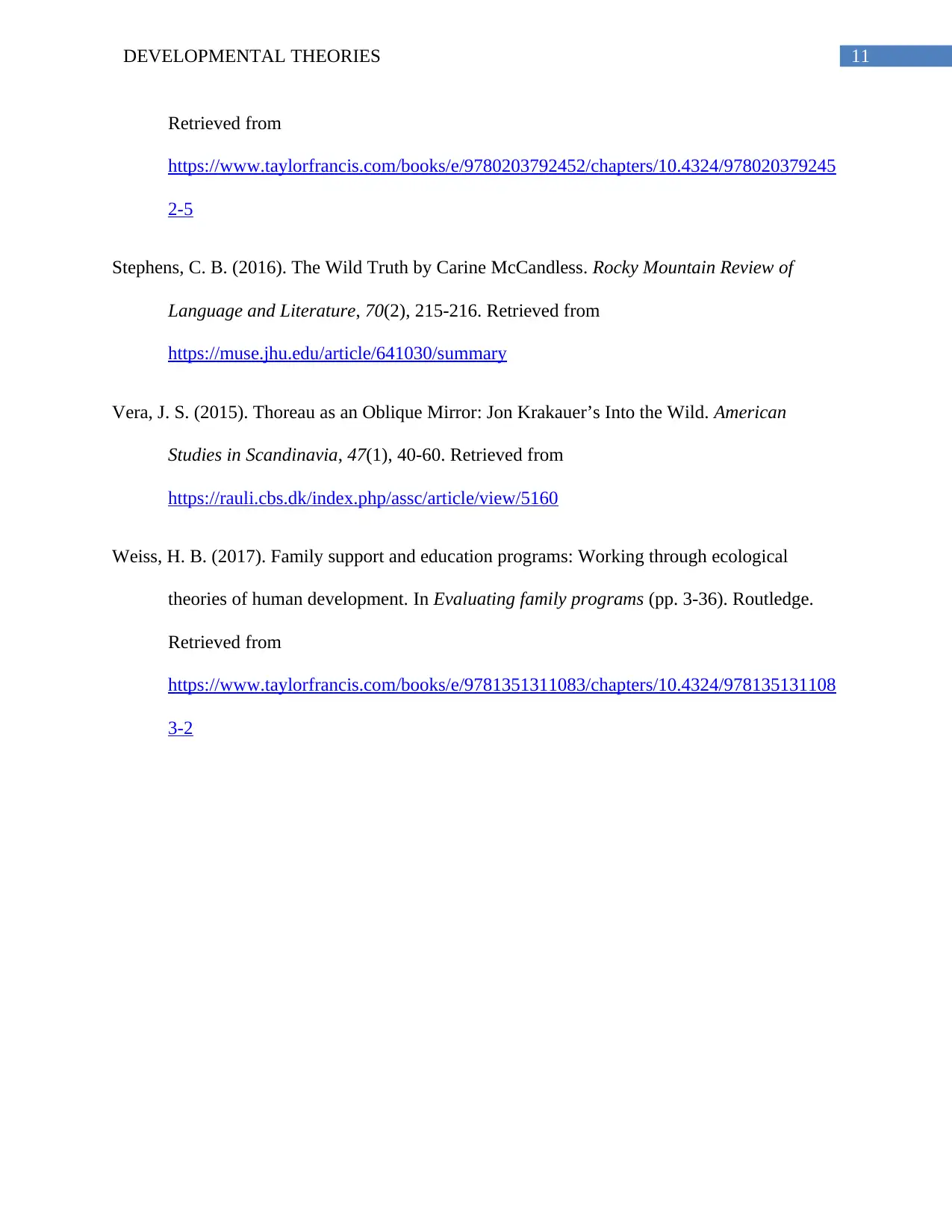
11DEVELOPMENTAL THEORIES
Retrieved from
https://www.taylorfrancis.com/books/e/9780203792452/chapters/10.4324/978020379245
2-5
Stephens, C. B. (2016). The Wild Truth by Carine McCandless. Rocky Mountain Review of
Language and Literature, 70(2), 215-216. Retrieved from
https://muse.jhu.edu/article/641030/summary
Vera, J. S. (2015). Thoreau as an Oblique Mirror: Jon Krakauer’s Into the Wild. American
Studies in Scandinavia, 47(1), 40-60. Retrieved from
https://rauli.cbs.dk/index.php/assc/article/view/5160
Weiss, H. B. (2017). Family support and education programs: Working through ecological
theories of human development. In Evaluating family programs (pp. 3-36). Routledge.
Retrieved from
https://www.taylorfrancis.com/books/e/9781351311083/chapters/10.4324/978135131108
3-2
Retrieved from
https://www.taylorfrancis.com/books/e/9780203792452/chapters/10.4324/978020379245
2-5
Stephens, C. B. (2016). The Wild Truth by Carine McCandless. Rocky Mountain Review of
Language and Literature, 70(2), 215-216. Retrieved from
https://muse.jhu.edu/article/641030/summary
Vera, J. S. (2015). Thoreau as an Oblique Mirror: Jon Krakauer’s Into the Wild. American
Studies in Scandinavia, 47(1), 40-60. Retrieved from
https://rauli.cbs.dk/index.php/assc/article/view/5160
Weiss, H. B. (2017). Family support and education programs: Working through ecological
theories of human development. In Evaluating family programs (pp. 3-36). Routledge.
Retrieved from
https://www.taylorfrancis.com/books/e/9781351311083/chapters/10.4324/978135131108
3-2
1 out of 12
Related Documents
Your All-in-One AI-Powered Toolkit for Academic Success.
+13062052269
info@desklib.com
Available 24*7 on WhatsApp / Email
![[object Object]](/_next/static/media/star-bottom.7253800d.svg)
Unlock your academic potential
© 2024 | Zucol Services PVT LTD | All rights reserved.